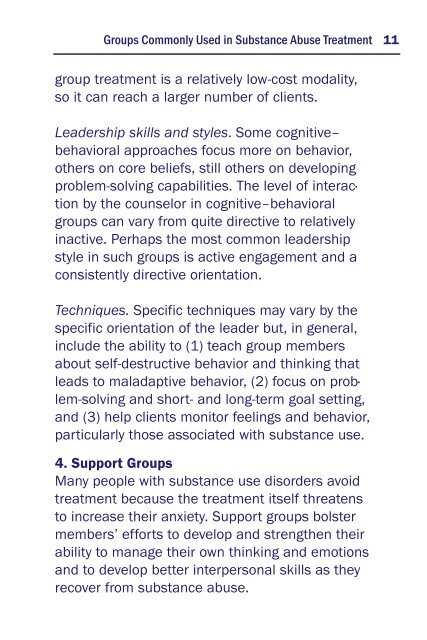Quick Guide for Clinicians - SAMHSA Store - Substance Abuse and ...
Quick Guide for Clinicians - SAMHSA Store - Substance Abuse and ...
Quick Guide for Clinicians - SAMHSA Store - Substance Abuse and ...
You also want an ePaper? Increase the reach of your titles
YUMPU automatically turns print PDFs into web optimized ePapers that Google loves.
Groups Commonly Used in <strong>Substance</strong> <strong>Abuse</strong> Treatment 11group treatment is a relatively low-cost modality,so it can reach a larger number of clients.Leadership skills <strong>and</strong> styles. Some cognitive–behavioral approaches focus more on behavior,others on core beliefs, still others on developingproblem-solving capabilities. The level of interactionby the counselor in cognitive–behavioralgroups can vary from quite directive to relativelyinactive. Perhaps the most common leadershipstyle in such groups is active engagement <strong>and</strong> aconsistently directive orientation.Techniques. Specific techniques may vary by thespecific orientation of the leader but, in general,include the ability to (1) teach group membersabout self-destructive behavior <strong>and</strong> thinking thatleads to maladaptive behavior, (2) focus on problem-solving<strong>and</strong> short- <strong>and</strong> long-term goal setting,<strong>and</strong> (3) help clients monitor feelings <strong>and</strong> behavior,particularly those associated with substance use.4. Support GroupsMany people with substance use disorders avoidtreatment because the treatment itself threatensto increase their anxiety. Support groups bolstermembers’ ef<strong>for</strong>ts to develop <strong>and</strong> strengthen theirability to manage their own thinking <strong>and</strong> emotions<strong>and</strong> to develop better interpersonal skills as theyrecover from substance abuse.
















